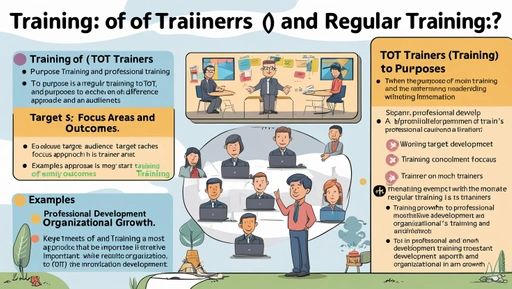TOT (Training of Trainers) vs. Training, In the realm of professional development and capacity building, two terms often come up: Training and Training of Trainers (TOT). While they may sound similar, they serve distinct purposes and cater to different audiences. Understanding the differences between the two is crucial for organizations, educators, and professionals aiming to maximize the effectiveness of their learning interventions. This article explores the concepts of Training and TOT, their key differences, and their respective roles in fostering skill development and knowledge transfer.
What is Training?
Training refers to the process of imparting specific skills, knowledge, or competencies to individuals or groups to enhance their performance in a particular area. It is a structured learning experience designed to address specific needs, such as improving technical skills, developing soft skills, or understanding new processes or tools. Training programs are typically tailored to the needs of the participants and are often delivered by subject matter experts or experienced trainers.
Key Characteristics of Training:
- Target Audience: Employees, students, or individuals seeking to acquire new skills or improve existing ones.
- Focus: Skill development, knowledge transfer, and performance improvement.
- Duration: Can range from short workshops to long-term courses, depending on the complexity of the topic.
- Outcome: Participants gain the ability to apply what they have learned directly to their work or personal lives.
- Delivery Methods: Classroom sessions, online courses, hands-on workshops, simulations, etc.
For example, a company might conduct a training session on using new software for its employees, or a school might organize a workshop for teachers on innovative teaching methods.
What is Training of Trainers (TOT)?
Training of Trainers (TOT) is a specialized form of training aimed at equipping individuals with the skills and knowledge needed to train others effectively. The primary goal of TOT is to create a pool of competent trainers who can then deliver training programs to a wider audience. TOT programs focus not only on the subject matter but also on teaching methodologies, communication skills, and strategies for engaging learners.
Key Characteristics of TOT:
- Target Audience: Experienced professionals, educators, or individuals who will be responsible for training others.
- Focus: Developing training delivery skills, understanding adult learning principles, and mastering facilitation techniques.
- Duration: Often longer than regular training programs, as it covers both content and pedagogy.
- Outcome: Participants become capable of designing, delivering, and evaluating training programs for others.
- Delivery Methods: Interactive workshops, role-playing, peer feedback, and practical training sessions.
For instance, a TOT program might be conducted for a group of senior employees who will later train their colleagues on a new company policy or for teachers who will train their peers on a new curriculum.

Key Differences Between Training and TOT
While both Training and TOT aim to enhance skills and knowledge, they differ in several key aspects:
| Aspect | Training | Training of Trainers (TOT) |
|---|---|---|
| Purpose | To develop specific skills or knowledge. | To prepare individuals to train others. |
| Audience | End-users or direct beneficiaries. | Future trainers or facilitators. |
| Content Focus | Subject matter expertise. | Training methodologies and delivery skills. |
| Outcome | Improved individual performance. | Creation of a skilled pool of trainers. |
| Duration | Shorter, focused on immediate needs. | Longer, covering both content and pedagogy. |
| Delivery Style | Direct instruction or hands-on practice. | Interactive, reflective, and practice-based. |
The Importance of Training
Training plays a vital role in personal and professional development. It helps individuals stay updated with the latest trends, technologies, and best practices in their field. For organizations, training is essential for maintaining a skilled workforce, improving productivity, and fostering innovation. Some key benefits of training include:
- Skill Enhancement: Training equips individuals with the skills needed to perform their tasks efficiently.
- Increased Confidence: Participants gain confidence in their abilities, leading to better job performance.
- Adaptability: Training helps individuals adapt to changes in their industry or workplace.
- Employee Retention: Organizations that invest in training often see higher employee satisfaction and retention rates.
- Improved Performance: Well-trained employees contribute to the overall success of the organization.
The Importance of Training of Trainers (TOT)
TOT is equally important, especially in scenarios where knowledge needs to be disseminated widely. By creating a network of skilled trainers, organizations can ensure that training programs are delivered consistently and effectively. The benefits of TOT include:
- Scalability: TOT enables organizations to scale their training efforts by creating multiple trainers who can reach a larger audience.
- Consistency: TOT ensures that training content and delivery methods are standardized across different sessions and trainers.
- Sustainability: A pool of trained trainers ensures that knowledge and skills are retained within the organization, even if individual trainers leave.
- Empowerment: TOT empowers individuals to take on leadership roles as trainers, fostering a culture of continuous learning.
- Quality Assurance: TOT programs often include feedback and evaluation mechanisms, ensuring high-quality training delivery.
When to Use Training vs. TOT
Choosing between Training and TOT depends on the specific needs and goals of the organization or individual. Here are some scenarios where each approach is most appropriate:
When to Use Training:
- When employees or individuals need to acquire specific skills or knowledge.
- When introducing new tools, technologies, or processes.
- When addressing performance gaps or skill deficiencies.
- When preparing individuals for new roles or responsibilities.
When to Use TOT:
- When there is a need to train a large number of people across different locations.
- When creating a sustainable training program within an organization.
- When developing internal trainers to reduce reliance on external experts.
- When ensuring consistency and quality in training delivery is critical.

Best Practices for Effective Training and TOT
To maximize the impact of both Training and TOT, consider the following best practices:
- Needs Assessment: Conduct a thorough analysis of the target audience’s needs to design relevant and impactful programs.
- Clear Objectives: Define clear learning objectives for both Training and TOT programs.
- Engaging Content: Use interactive and engaging methods to keep participants motivated and involved.
- Practical Application: Incorporate hands-on activities, case studies, and real-world examples to reinforce learning.
- Feedback and Evaluation: Collect feedback from participants and evaluate the effectiveness of the program to make continuous improvements.
- Follow-Up: Provide ongoing support and resources to ensure that participants can apply what they have learned.
Conclusion
Training and Training of Trainers (TOT) are both essential components of professional development, but they serve different purposes and cater to different audiences. Training focuses on equipping individuals with specific skills and knowledge, while TOT prepares individuals to train others effectively. By understanding the differences and leveraging the strengths of both approaches, organizations can create a robust learning ecosystem that fosters growth, innovation, and sustainability. Whether you are looking to enhance individual performance or build a network of skilled trainers, investing in the right type of program is key to achieving your goals.

5 thoughts on “TOT (Training of Trainers) vs. Training”
Comments are closed.